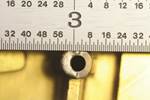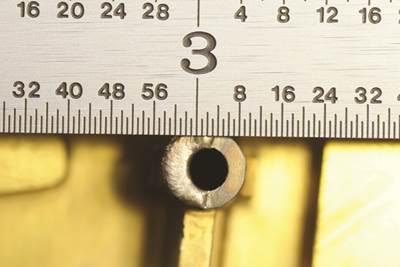The United States Microscopic Welding Association: Marrying Education and Technology
The latest in products and technology joins together with hands-on learning to keep members on top of the latest trends in microwelding..
Back in 2002, a few members of the microscopic welding community got together for a candid discussion of technology, equipment and pricing,and how this industry would move forward. As a result, the Pawtucket, RI-based United States Microscopic Welding Association, Inc. (USMWA) was formed to serve as a "stable vehicle for members to participate in while building solid, successful relationships within the microscopic welding industry," according to its mission statement.
Lee Gilbert,president and CEO of the USMWA,notes that his organization wishes to promote past, present and future technology to further the precision microscopic welding industry and the industries that benefit from welding. Furthermore, it provides welding products and services to its members from manufacturers that are screened and approved by the USMWA at competitive rates. "An entire industry is bonded together,embracing ethical behavior and trust for one another," Gilbert notes. "Business relationships will be forged to further strengthen the industry and eventually, the size of the association will determine the future of the industry."
Membership Benefits
According to Gilbert, USMWA members have access to "Beta-tested products that have been approved by qualified microscopic welders with the best possible price negotiated for each and every product or service." The three basic product offerings are welding wire, tungsten and micro-burrs. For $125 a year, members have access to new technology, technical support, products and equipment. Gilbert points out that after one reasonable order, the membership fee pays for itself. Members also have an open forum to ask questions and exchange ideas. "Nothing is hidden, it's all out in the open," Gilbert notes. "We figure that is the best way to make our members feel they are part of something that is unique and worthwhile."
Gilbert had to do his homework to hunt down cutting-edge welding products and equipment. "I aligned myself with various manufacturers, like Pro-Fusion Technologies, Inc. (Rexburg, ID), Old School Industries, Inc. (Erie, CO), Vaniman Manufacturing Co. (FallBrook, CA), and LaserStar Technologies (Riverside, RI)," he states. "Then we got technical equipment,like Micro TIG power sources, Micro Plasma power sources, tungsten grinders, microscopes, illumination systems, microscope stands, microabrasive blasting systems and blasting media, laser tool welding equipment and options, hot plates, torches, ultrasonic cleaning units, non-hazardous cleaning chemicals and everything necessary to cover every step in the process of precision microscopic welding,sent to our Training/Technical Center in Forest City, North Carolina.
"The equipment was tested, retested and then we either gave each piece thumbs up or thumbs down," Gilbert continues. "If we put our thumbs down we moved on and found a different piece of equipment by a different manufacturer. Once we had all of the equipment in place with better prices than what the manufacturers sell it for, we put it all in place and offer it to our members."
Additionally, the association offers an intense training and certification program in both Precision Micro TIG and Precision Micro Laser Tool Welding at three different levels: beginner, intermediate and advanced. "To determine someone's level of expertise, we give a pretraining test," Gilbert explains. "Once we evaluate the results, we can place them in the proper training program.
"Courses are offered year-round," Gilbert adds. "A member can attend a two-day class,eight to 10 hours a day,and receive hands-on and theoretical training, and also receive a training certificate. Training usually needs to be booked at least two to three months in advance; we are backlogged now."
Growing Pains
Currently the USMWA has about 60 member companies, and has established chapters in other countries like India, Puerto Rico, Costa Rica and Canada. "As stated, we are a technology-based organization and by sharing technology globally, we also sell American products that otherwise would not be sold," Gilbert emphasizes. "By increasing membership we can improve on the selection of products and prices,offering more for less with the same standard of quality." Advertising, word of mouth, and direct mailing are the methods the association employs to get the word out, but Gilbert points out that the Web site and training have been paramount in increasing the USMWA's exposure.
Currently, the USMWA's number-one goal is increasing its membership. Then, according to Gilbert, a number of things can happen: ongoing R&D into new products, which have to be tested; and building a database of technical information and making it available to everyone, to name a few. "Eventually, we'd like to sponsor some type of scholarship fund for those who want to get into the field of microscopic welding."
Gilbert, Gary Filer, VP in charge of training and technical, and Steve Sutton, technical research, are in the process of writing a training manual, which the USMWA hopes to eventually offer in an interactive CD as another means for members to train themselves or their employees. "The strength of this organization lies in the fact that it is technology-based, and the uniqueness lies in the fact that the members share technology with each other," Gilbert emphasizes. "It works."
Related Content
Think Safety: Eliminate Hazards Throughout the Shop
The tooling community is taking advantage of new products for safer mold shops and molding facilities.
Read MoreMMT Chats: Solving Schedule and Capacity Challenges With ERP
For this MMT Chat, my guests hail from Omega Tool of Menomonee Falls, Wisconsin, who share their journey with using enterprise resource planning (ERP)—and their people—to solve their schedule and capacity load monitoring challenges.
Read MoreOEE Monitoring System Addresses Root Cause of Machine Downtime
Unique sensor and patent-pending algorithm of the Amper machine analytics system measures current draw to quickly and inexpensively inform manufacturers which machines are down and why.
Read MoreThe Trifecta of Competitive Toolmaking
Process, technology and people form the foundations of the business philosophy in place at Eifel Mold & Engineering.
Read MoreRead Next
Laser Welding Versus Micro Welding
The latest battle in finely detailed restoration/repair of mold materials.
Read MoreAre You a Moldmaker Considering 3D Printing? Consider the 3D Printing Workshop at NPE2024
Presentations will cover 3D printing for mold tooling, material innovation, product development, bridge production and full-scale, high-volume additive manufacturing.
Read MoreReasons to Use Fiber Lasers for Mold Cleaning
Fiber lasers offer a simplicity, speed, control and portability, minimizing mold cleaning risks.
Read More





















